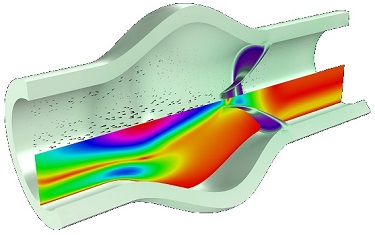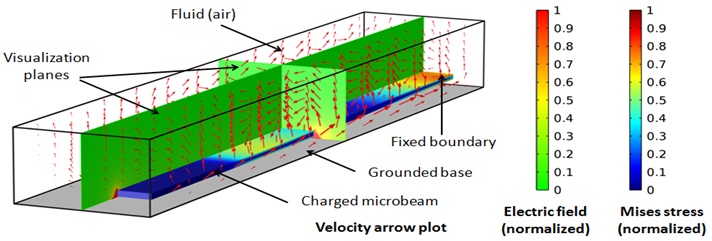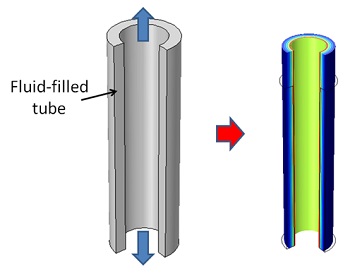Fluid-structure interaction refers to the analyses involving simultaneous fluid flow and solid deformation. Depending upon the problem, the interaction may be along a shared boundary or it may be internal to the structure, as in the case of poroelasticity. In addition to the solid and fluid deformation, FSI requires handling a moving mesh.
Veryst Engineering has worked on a wide range of FSI problems of different complexities. FSI problems may involve sources of nonlinearity in the solid part (large deformations, contact or nonlinear materials), or the fluid part (turbulence, non-Newtonian fluid properties, or multiphase flow). There could also be additional complexity in solver selection since the ideal solvers for structural and fluid equations are different. The degree of coupling between the fluid and solid fields may be weak or strong, which also affects the solver selection. Finally, mesh movement may be a source of complexity for problems with contact or large deformations, such as shown in the figure below.
FSI problems frequently involve coupling to other physics fields such as heat transfer or electromagnetics. The figure below shows an electrostatic-fluid-structure interaction analysis of a MEMS switch in an enclosed space, surrounded by air. The electrostatic force between beam and ground was calculated directly from the Maxwell stress tensor and accounts for fringe effects.
For some FSI problems we use our engineering judgement to create non-standard FSI models that reduce complexity and solution time. The example in Figure 4 involves the stretching of a fluid-filled tube. We completely removed the fluid part of the model and replaced it by a volumetric constraint when the fluid is a liquid, or a pressure-volume relationship when it is a gas. The reduced model was significantly faster than the full FSI model and the two models predicted very similar results for cases where inertia effects were negligible
Example: Peristaltic Pump
Peristaltic pumps move fluid by squeezing an elastomeric tube causing the fluid inside the tube to follow the motion of the roller. Veryst developed FSI models that capture the deformation of the tube, rollers, and fluid, the fluid-structure interaction, and contact interaction between the rollers and the hose.
We used the models to investigate the effect of pump design variations such as tube occlusion, tube diameter, and roller speed, on the flow rate, flow fluctuations, and stress state on the tube, thereby improving pump performance. For more details, see Peristaltic Pump Fluid-Structure Interaction.
Example: Sea Floor Energy Harvesting
Veryst Engineering provides energy harvesting design solutions for a variety of industries. One example is harvesting energy from constant, low speed ocean floor currents to power ocean floor sensors. Such sensors are used in naval applications, environmental monitoring, earthquake monitoring, and oil exploration. For more details, see Sea Floor Energy Harvesting.




